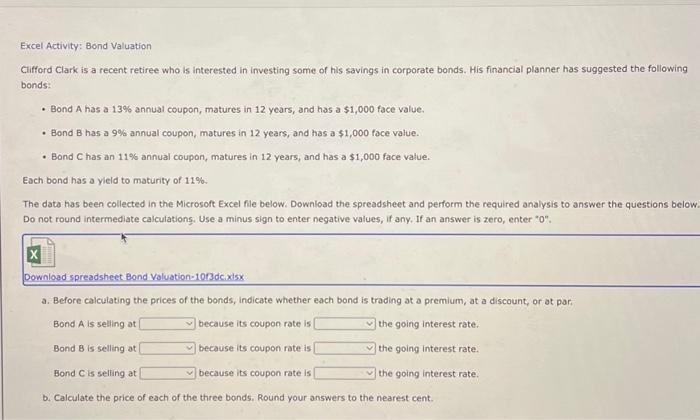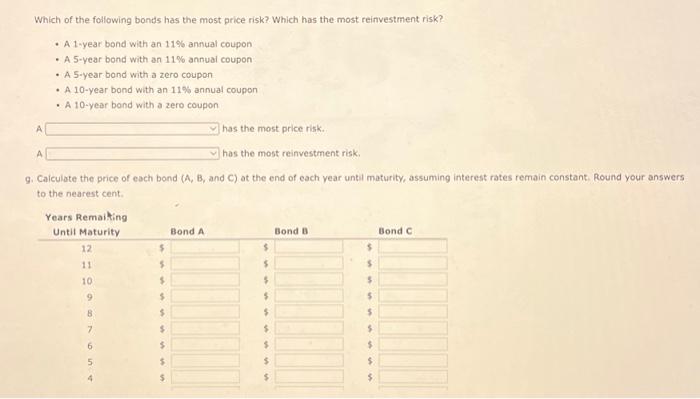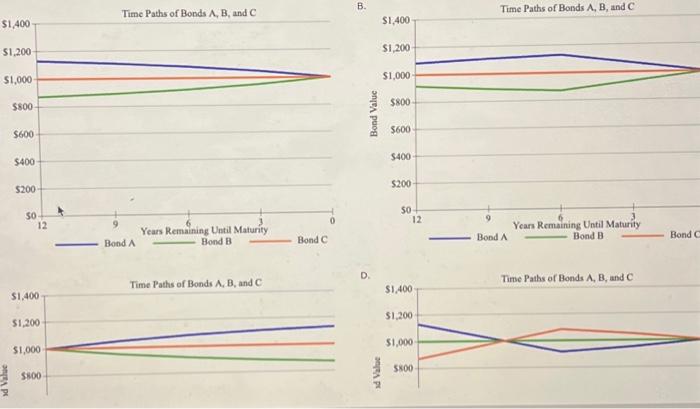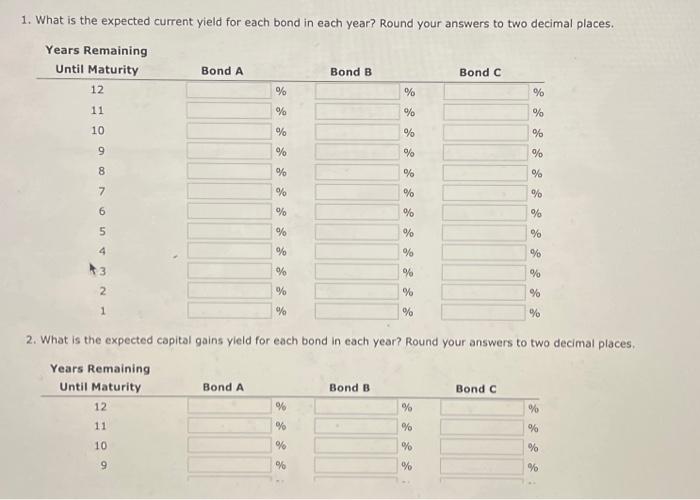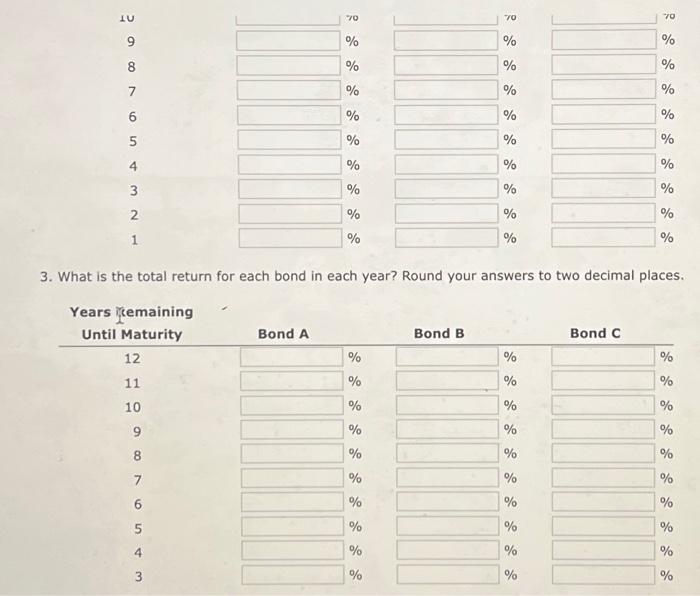Which of the following bonds has the most price risk? Which has the most reinvestment risk? - A 1-year bond with an 11% annual coupon - A 5-year bond with an 11% annual coupon - A. 5-year bond with a zero coupon - A 10-year bond with an 11% annual coupon - A 10-year bond with a zero coupon A has the most price risk. A has the most reinvestment risk. 9. Catculate the price of each bond (A, B, and C) at the end of each year until maturity, assuming interest rates remain constant. Round your answers to the nearest cent. 1. What is the expected current yield for each bond in each year? Round your answers to two decimal places. 2. What is the expected capital gains yield for each bond in each year? Round your answers to two decimal places. Time Paths of Bonds A, B, and C B. Time Paths of Bonds A, B, and C $1,400 $1,200 $1,000 Yean Remaining Until Maturity Bond A Bond B Bond C D. $1,400 Time Paths of Bonds A, B, and C 51,400 51,200 $1,000 5100 Time Paths of Bonds A, B, and C $1,200 51,000 3. 5800 What is the expected capital gains yield for each bond? What is the expected total return for each bond? Round your answers to two decimal places e. Mr. Clark is considering another bond, Bond D. It has a 9% semiannual coupon and a $1,000 face value (i.e., it pays a $45 coupon every 6 months). Bond D is scheduled to mature in 8 years and has a price of $1,110. It is also callable in 5 years at a call price of $1,020. 1. What is the bond's nominal yield to maturity? Round your answer to two decimal places. 2. What is the bond's nominal yield to call? Round your answer to two decimal places. 3. If Mr. Clahumeric field: Because the YTM is the YTC, Mr. Clark expect the bond to be called, Consequently, he woutd earn f. Explain briefly the difference between price risk and reinvestment risk. This risk of a decline in bond values due to an increase in interest rates is called interest rates is called The risk of an income decline due to a drop in Which of the following bonds has the most price risk? Which has the most reirvestment risk? - A 1 -year bond with an 11% annual coupon - A 5-vear hond with an 110 h annual counon Create a graph showing the time path of each bond's value. Choose the correct graph. The correct graph is Excel Activity: Bond Valuation Ciifford Clark is a recent retiree who is interested in investing some of his savings in corporate bonds. His financial planner has suggested the following bonds: - Bond A has a 13% annual coupon, matures in 12 years, and has a $1,000 face value. - Bond B has a 9% annual coupon, matures in 12 years, and has a $1,000 foce value. - Bond C has an 11% annual coupon, matures in 12 years, and has a $1,000 face value. Each bond has a yield to maturity of 11%. The data has been collected in the Microsof Excel file below. Download the spreadsheet and perform the required analysis to answer the questions below Do not round intermediate calculations, Use a minus sign to enter negative values, if any. If an answer is zero, enter " 0 ". a. Before calculating the prices of the bonds, indicate whether each bond is trading at a premium, at a discount, or at par. Bond A is selling ot because its coupon rate is the going interest rate. Bond B is selling at because its coupon rate is the going interest rate. Bond C is seling at because its coupon rate is the going interest rate. b. Calculate the price of each of the three bonds. Round your answers to the nearest cent. b. Calculate the price of each of the three bonds. Round your answers to the nearest, cent. Price (Bond A): $ Price (Bond B):$ Price (Bond C): 5 c. Calculate the current yield for each of the three bonds. (Hint: The expected current yield is calculated as the annual interest divided by the price of the bond.) Round your answers to two decimal places. Current yield (Bond A): Current yield (Bond B): % Current yleld (Bond C): d. If the yield to maturity for each bond remains at 11%, what will be the price of each bond 1 year from now? Round your answers to the nearest cent: Price (Bond A ): $ Price (Bond 8):$ Price (Bond C) is 3. What is the total return for each bond in each year? Round your answers to two decimal places
